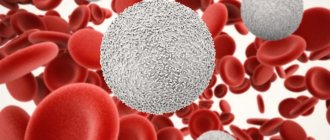Glycated hemoglobin is one of the main markers of diabetes; it is a stable compound of glucose with hemoglobin, which remains in the bloodstream for a long time. Glycated hemoglobin appears as a result of the Maillard reaction, which is irreversible. As a result, very stable compounds of blood proteins and carbohydrates are formed.
Since the lifespan of red blood cells is approximately 3 months, determining the level of glycohemoglobin makes it possible to identify disturbances in glucose metabolism that occurred during this period. This simplifies the diagnosis of latent forms of diabetes, when all other indicators in the blood may be within the normal range.
The persistence of a high level of glycated hemoglobin in people with diabetes mellitus may indicate the ineffectiveness of the treatment received and a high level of risk of various complications.
Description of the analysis for glycated hemoglobin
Glycohemoglobin is present in the blood of any person; the main difference between a healthy person and a sick person is that in a person suffering from diabetes, the amount of this compound greatly exceeds the norm.
Moreover, analysis for glycated hemoglobin allows not only to detect diabetes in the early stages, but also to determine the tendency to develop this disease. Therefore, the test should be carried out even for healthy people at least once a year. This will make it possible to timely detect disturbances in carbohydrate metabolism and apply effective preventive measures, as a result the person will remain healthy and prevent the development of diabetes, which is much more difficult to combat.
It should be taken into account that some congenital pathologies can affect the level of glycosylated hemoglobin. For example, in patients with sickle cell anemia, its amount will be noticeably lower than normal.
The main advantages of the glycohemoglobin test include:
- Can be done at any time, even immediately after eating.
- One of the simplest and fastest tests to diagnose diabetes.
- Serves as a reliable indicator of how the diabetic has controlled sugar levels in the previous 2-3 months.
- The accuracy of the analysis is almost unaffected by extraneous factors (infections, physical activity, alcohol intake).
Thanks to the high reliability of this study, the doctor is able to prescribe appropriate therapy and make the necessary adjustments to treatment regimens in a timely manner. Therefore, patients with an established diagnosis of diabetes mellitus should donate blood for glycosylated hemoglobin every 3-4 months.
Rapid tests to determine this indicator have not yet been developed, so samples are taken only in medical institutions with a referral from the attending physician.
What does the analysis show?
A glycated hemoglobin test is necessary to assess blood glucose levels over a long period of time. The research is based on the process of glucose attaching to hemoglobin (a protein in red blood cells), which carries oxygen. On average, red blood cells live for 3 months. The analysis is relevant for diagnosing prediabetes.
“Prediabetes is an increase in blood glucose levels, but not so high as to make a diagnosis of diabetes,” explains Lyubava Kazakova, general practitioner at ELISA Medical Center. - To determine prediabetes, you need to take a glycated hemoglobin test - this is your blood sugar level over 3 months. If the test result is from 5.7% to 6.3%, then a diagnosis of “prediabetes” may be made. If more than 6.5%, then a diagnosis of diabetes is made.
The doctor will prescribe a test for the following indications:
- High blood glucose levels or the upper limit of normal.
- Age 40+.
- Risk group: overweight, obesity, heredity.
- Complaints: thirst, dry mouth, frequent urge to urinate, decreased vision, itchy skin.
- Monitoring the treatment of already diagnosed diabetes mellitus types 1 and 2.
“The level of glycated hemoglobin is, first of all, interesting because it allows us to estimate the average blood glucose level over 3 months, therefore, it helps to determine the violation of carbohydrate absorption,” comments Danil Khaziev, general practitioner at the ELISA Medical Center. — It is worth conducting such an examination for the first time if the fasting glucose level tends to the upper limit of normal. Also, this examination is simply necessary for patients with diabetes to assess the effectiveness of therapy.
What do the study results mean?
Depending on the information received, one can judge the state of a person’s carbohydrate metabolism. A result of 4 to 5.7% is considered normal; it indicates normal processes of sugar metabolism, no risk of developing diabetes or other diseases that are accompanied by changes in this indicator.
Deviations above normal:
- From 5.6 to 6%. It means that the disease has not yet developed, but the person has a tendency to disrupt glucose metabolism, is at risk and requires the appointment of preventive measures. In most cases, improving your diet and regular physical activity will be enough to normalize your indicators.
- From 6.1 to 6.4%. Indicates a high degree of risk and requires additional research. They will allow you to identify the degree of activity of the pathological process and select the most effective preventive measures.
- From 6.5 to 7%. Indicates the development of diabetes in the early stages. To clarify the prognosis, additional research methods are prescribed. Then the doctor will prescribe a suitable treatment regimen; after 3-4 months a repeat test for glycohemoglobin will be required.
- Above 7%. A marker for the development of diabetes and serious disorders of glucose metabolism. Requires immediate contact with an endocrinologist to receive adequate therapy and reduce the risk of complications.
An increase in glycated hemoglobin levels does not always indicate the development of diabetes. For example, newborns retain a high level of fetal hemoglobin for some time, which reacts better with glucose. In the first months of life, this test will demonstrate high glycohemoglobin values.
Factors that can provoke an excess of the normal level of glucose-bound hemoglobin also include iron deficiency, removal of the spleen, disturbances in the functioning of the thyroid gland and other endocrine glands. As a result of these pathologies, the processes of red blood cell renewal slow down, which leads to an increase in the amount of hemoglobin associated with sugars, since these compounds are very persistent and can persist for a long time.
Deviations towards a decrease in the amount of glycated hemoglobin may also be observed. Such results are quite rare and may indicate long-term hypoglycemia or renal failure. A sharp decrease in the level of glycohemoglobin is also observed after massive blood loss, internal hemorrhages and serves as a marker of the active functioning of the hematopoietic system. At the same time, the rate of formation of new red blood cells and renewal of hemoglobin in the blood increases significantly, which leads to a decrease in the indicator below normal values.
How to maintain normal glycated hemoglobin?
In order for the level of glycated hemoglobin to remain normal, it is important to pay attention to lifestyle and nutrition.
“To maintain this indicator in the normal range, first of all, it is necessary to follow the general principles of a healthy lifestyle (rational nutrition, physical activity), explains Danil Khaziev, general practitioner at the ELISA Medical Center. — If you already have a carbohydrate metabolism disorder, you need to regularly take medications as part of the therapy prescribed by your doctor.
If glycated hemoglobin is at the upper limits or exceeds the norm, then it is recommended to consult a nutritionist, endocrinologist or therapist to draw up an individual nutrition plan with a limitation of easily digestible carbohydrates. It is also necessary to increase the amount of physical activity. This will help prevent the development of type 2 diabetes.
Detailed description of the study
Hemoglobin is a protein whose role is to transport oxygen from the blood to the tissues. It is found inside red blood cells—red blood cells—that are produced in the bone marrow. The average lifespan of these blood cells is 90 to 120 days, after which they are destroyed in the spleen.
Diabetes mellitus leads to excess glucose in the blood. The reason for this may be either a decrease in the sensitivity of tissues to the hormone insulin (insulin resistance) or the destruction for some reason of the pancreatic cells that secrete this hormone. The most important role of insulin is to ensure access of glucose to tissue cells; a lack of the hormone causes an increase in its concentration in the blood.
Penetrating into the red blood cell, glucose forms a compound with hemoglobin, which can only be destroyed together with the cell in the spleen at the end of the life cycle of 2-3 months. Accordingly, a study of the level of glycated hemoglobin in the blood allows us to determine the severity of carbohydrate metabolism disorders, that is, an increase in glucose concentration, for approximately 3 months before the analysis.
Due to the fact that glycation or glycosylation is the addition of glucose to any molecule, hemoglobin in this case is called glycated (glycosylated). Currently, the first version of the name is more common. Another designation for it is in the form of an abbreviation -HbA1c.
Glycated hemoglobin is also present in the blood of a healthy person, but in very small quantities. Its level increases in diabetes mellitus, so HbA1c is now recognized as an important diagnostic marker for this disease.
An endocrinologist diagnoses and selects treatment for diabetes mellitus. Symptoms of this disease are:
- Increased thirst;
- Frequent, excessive urination;
- Weight change (loss/gain);
- Increased feeling of hunger;
- Pathological fatigue;
- Decreased vision;
An HbA1c test allows you to diagnose diabetes mellitus and prediabetic conditions, monitor the condition of patients diagnosed with diabetes mellitus, and also regulate glucose levels with the chosen treatment tactics.
Complexes with this research
Advanced women's anti-aging diagnostics Advanced monitoring of basic blood parameters in women aged 40+ 21,130 R Composition
Monitoring of diabetes Monitoring of the condition of patients with diabetes mellitus (once every 6 months) 1,900 R Composition
Male check-up No. 1 39 studies for annual preventive examination RUB 12,740 Composition
IN OTHER COMPLEXES
- Advanced anti-aging diagnostics in postmenopause RUB 21,510
- Advanced male anti-aging diagnostics RUB 25,030
- Biochemistry of blood. 19 indicators 4,060 R
- Risk of severe COVID-19 710 RUR
- Women's anti-aging diagnostics RUR 8,130
Glycosylated (glycated) hemoglobin (determination of blood levels)
What is it for
An analysis for glycosylated hemoglobin allows you to assess the level of glycemia (blood glucose) over the past 1-3 months by measuring its percentage.
Glycosylated hemoglobin determines the level of compensation and the risk of complications of diabetes mellitus. Glycosylated hemoglobin is a compound of glucose and hemoglobin that is found in the blood in healthy people, but increases in patients with diabetes.
Hemoglobin is a protein found in blood cells (red blood cells) that carries oxygen. Among the various forms of hemoglobin, hemoglobin A predominates (95-98%). Glucose circulating in the blood can spontaneously bind to hemoglobin A.
The resulting compound (glycosylated hemoglobin) remains in erythrocytes throughout the lifespan of blood cells; on average, the lifespan of erythrocytes can reach up to 120 days, so glycated hemoglobin reflects hyperglycemia during this period (the average lifespan of erythrocytes is 60 days).
Thus, the higher the level of glycated hemoglobin in the patient’s blood, the higher the level of glucose (glycemia) in relation to the norm over the past 1-3 months and the higher the risk of complications of diabetes mellitus. The addition of glucose to hemoglobin and other proteins leads to disruption of protein functions, which leads to complications. Monitoring glycated hemoglobin helps to minimize complications of diabetes - progressive damage to organs (kidneys (nephropathy), eyes (blindness, retinopathy), cardiovascular system (coronary disease, strokes, heart attacks), nervous system (damage to peripheral nerves and blood vessels, neuropathy) ) and mortality risk in general.
The predominant form of glycated hemoglobin is the A1c form, which closely correlates with the severity of diabetes mellitus.
Glycated hemoglobin is tested as part of the screening and diagnosis of prediabetes and diabetes in adults. Patients with diabetes mellitus (DM) donate glycated hemoglobin to monitor the effectiveness of diabetes treatment. The glycated hemoglobin level should be monitored at least several times a year in patients with diabetes mellitus who have achieved target values as a result of treatment and quarterly, and 4 times a year in patients with diabetes mellitus who have not achieved target values or when there is a change in tactics or treatment regimen.
Determination of the level of glycated hemoglobin is prescribed in the presence of risk factors, if diabetes is suspected or to confirm diabetes mellitus. Symptoms of diabetes mellitus may include nausea, vomiting, a feeling of dry mouth, constant thirst, increased appetite, unreasonable weight loss, frequent urge to urinate, weakness and a feeling of fatigue, numbness or tingling in the extremities, blurred vision, etc.
It is still recommended to use a fasting glucose test or performing a glucose tolerance test.
Glycated hemoglobin and diabetes mellitus
Glycated hemoglobin is recommended to be given to patients with risk factors for diabetes:
- sedentary lifestyle;
- if there are first-degree relatives with diabetes in the family (parents, brother, sister);
- overweight;
- people of high-risk ethnicity (Hispanics, African Americans, Native Americans, Asian Americans, Pacific Islanders);
- hypertension;
- abnormalities in the lipid profile (low HDL, high triglycerides);
- insulin resistance;
- women with PCOS (polycystic ovary syndrome);
- a history of cardiovascular disease;
- impaired glucose tolerance.
In the absence of risk factors for diabetes, the American Diabetes Association (ADA) recommends testing glycated hemoglobin levels in all patients over 45 years of age every three years.







